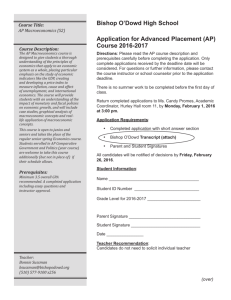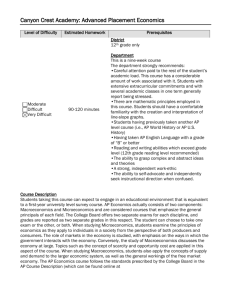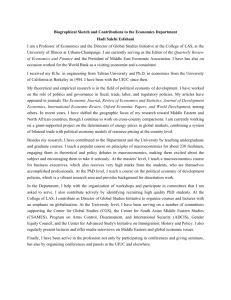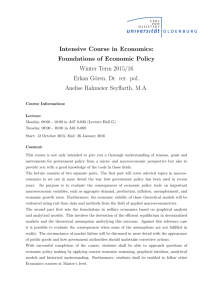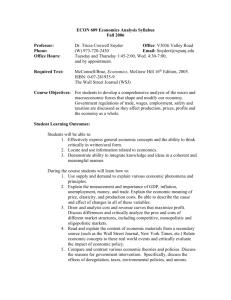Eco 102 Course outline 2015-2016
advertisement
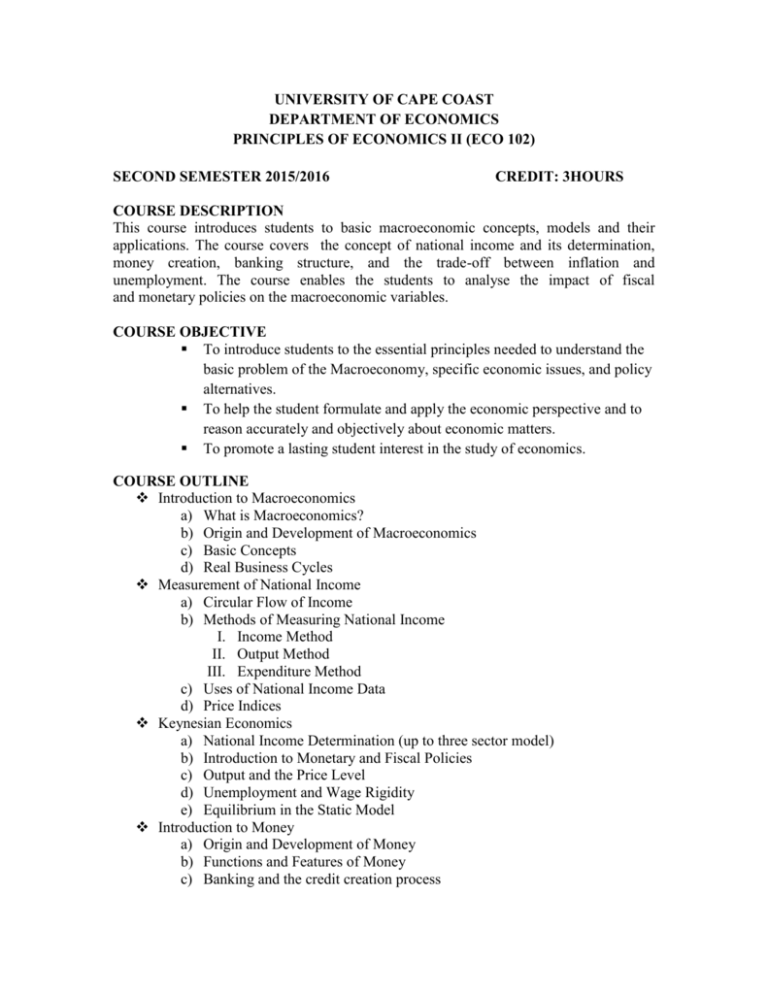
UNIVERSITY OF CAPE COAST DEPARTMENT OF ECONOMICS PRINCIPLES OF ECONOMICS II (ECO 102) SECOND SEMESTER 2015/2016 CREDIT: 3HOURS COURSE DESCRIPTION This course introduces students to basic macroeconomic concepts, models and their applications. The course covers the concept of national income and its determination, money creation, banking structure, and the trade-off between inflation and unemployment. The course enables the students to analyse the impact of fiscal and monetary policies on the macroeconomic variables. COURSE OBJECTIVE To introduce students to the essential principles needed to understand the basic problem of the Macroeconomy, specific economic issues, and policy alternatives. To help the student formulate and apply the economic perspective and to reason accurately and objectively about economic matters. To promote a lasting student interest in the study of economics. COURSE OUTLINE Introduction to Macroeconomics a) What is Macroeconomics? b) Origin and Development of Macroeconomics c) Basic Concepts d) Real Business Cycles Measurement of National Income a) Circular Flow of Income b) Methods of Measuring National Income I. Income Method II. Output Method III. Expenditure Method c) Uses of National Income Data d) Price Indices Keynesian Economics a) National Income Determination (up to three sector model) b) Introduction to Monetary and Fiscal Policies c) Output and the Price Level d) Unemployment and Wage Rigidity e) Equilibrium in the Static Model Introduction to Money a) Origin and Development of Money b) Functions and Features of Money c) Banking and the credit creation process d) Tools of Monetary Control Introduction to International Trade Theory a) Absolute Cost Advantage b) Comparative Cost Advantage c) Gains from Trade Mode of assessment 1. Two quizzes (30%) 2. One project work (10%) 3. One End-of-Semester exam (60%). READING LIST 1. King, David (2012). Economics. New York: Oxford University Press Inc. 2. Lipsey, G. and Chrystal, A. (2011). Economics, 12th Edition. New York: Oxford University Press Inc. 3. Hubbard, G.R., Obrien, A.P. & Rafferty, M. (2012). Macroeconomics. PrenticeHall, New Jersey 4. Case, K.E., Fair, R.C. & Oster, S.M. (2012). Principles of Macroeconomics. 10th Ed. Prentice-Hall, London. 5. Case, K.E., Fair, R.C. & Oster, S.M. (2009). Principles of Economics II. 9th Ed. Prentice-Hall, London. 6. Lipsey, G. and Chrystal, A. (2007). Economics, 11th Edition. New York: Oxford University Press. 7. Lipsey, G. and Chrystal, A. (2004). Economics, 10th Edition. New York: Oxford University Press. 8. Nellis, J. & Parker, D. (2004). Principles of macroeconomics. Prentice-Hall, London 9. McConnell, C. and Brue, S. (2002). Economics: Principles, Problems and Polices. New York: McGraw-Hill Higher Education. 10. Vaish, M.C. (2002). Macroeconomic Theory, 12th Rev. Ed. Vikas Publishing House Ltd. New Delhi. 11. Mankiw, G. (1998), Principles of Macroeconomics. 2nd Edition. 12. Parkin, M. and Bade, R. (1995). Modern Macroeconomics. 4th Ed. Prentice-Hall, Inc. New Jersey. 13. Hardwick, P., Khan, B. and Langmead, J. (1994). An Introduction to Modern Economics. 4th Edition, Adison Wesley, New York. 14. Abel, A. and Bernanke, B. (1994). Macroeconomics, 2nd Edition.Adison-Wesley Inc., New York. 15. Baumol, W. & Blinder, A. (1991) Macroeconomics: principles and policy. 5th ed. San Diego: Harcourt Brace Jovanovich


